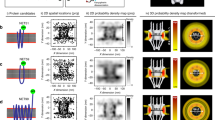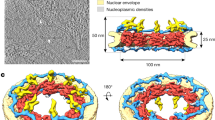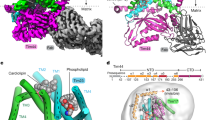Abstract
THE import of nuclear proteins proceeds through the nuclear pore complex and requires nuclear localization signals (NLSs)1,2, energy3,4 and soluble factors5, namely importin-α(Mr 60K)6-12,28, importin-β (90K)8-11,13 and Ran14,15. Importin-α is primarily responsible for NLS recognition6-12,29 and is a member of a protein family that includes the essential yeast nuclear pore protein SRPlp (ref. 16). As the first event, the complex of importin-α and importin-β binds the import substrate in the cytosol8,9. Here we show that this nuclear pore targeting complex initially docks as a single entity to the nuclear pore via importin-β. Then the energy-dependent, Ran-mediated translocation through the pore results in the accumulation of import substrate and importin-α in the nucleus. In contrast, importin-β accumulates at the nuclear envelope, but not in the nucleoplasm. Immunoelectron microscopy detects importin-β on both sides of the nuclear pore. This suggests that the nuclear pore targeting complex might move as a single entity from its initial docking site through the central part of the nuclear pore before it disassembles on the nucleoplasmic side.
This is a preview of subscription content, access via your institution
Access options
Subscribe to this journal
Receive 51 print issues and online access
$199.00 per year
only $3.90 per issue
Buy this article
- Purchase on Springer Link
- Instant access to full article PDF
Prices may be subject to local taxes which are calculated during checkout
Similar content being viewed by others
References
Dingwall, C., Sharnick, S. V. & Laskey, R. A. Cell 30, 449–458 (1982).
Kalderon, D., Roberts, B. L., Richardson, W. D. & Smith, A. E. Cell 39, 499–509 (1984).
Newmeyer, D. D. & Forbes, D. J. Cell 52, 641–653 (1988).
Richardson, W. D., Mills, A. D., Dilworth, S. M., Laskey, R. A. & Dingwall, C. Cell 52, 655–664 (1988).
Adam, S. A., Sterne-Marr, R. & Gerace, L. J. Cell Biol. 111, 807–816 (1990).
Adam, S. A. & Gerace, L. Cell 66, 837–847 (1991).
Görlich, D., Prehn, S., Laskey, R. A. & Hartmann, E. Cell 79, 767–778 (1994).
Görlich, D. et al. Curr. Biol. 5, 383–392 (1995).
Imamoto, N., Tachibana, T., Matsubae, M. & Yoneda, Y. J. biol. Chem. 270, 8559–8565 (1995).
Moroianu, J., Blobel, G. & Radu, A. Proc. natn. Acad. Sci. U.S.A. 92, 2008–2011 (1995).
Radu, A., Blobel, G. & Moore, M. S. Proc. natn. Acad. Sci. U.S.A. 92, 1769–1773 (1995).
Weis, K., Mattaj, I. W. & Lamond, A. I. Science 268, 1049–1051 (1995).
Chi, N. C., Adam, E. J. H. & Adam, S. A. J. Cell Biol. 130, 265–274 (1995).
Moore, M. S. & Blobel, G. Nature 365, 661–663 (1993).
Melchior, F., Paschal, B., Evans, J. & Gerace, L. J. Cell Biol. 123, 1649–1659 (1993).
Yano, R., Oakes, M., Yamaghishi, M., Dodd, J. A. & Nomura, M. Molec. cell. Biol. 12, 5640–5651 (1992).
Moore, M. S. & Biobel, G. Proc. natn. Acad. Sci. U.S.A. 91, 10212–10216 (1994).
Paschal, B. M. & Gerace, L. J. Cell Biol. 129, 925–937 (1995).
Adam, S. A., Lobl, T. J., Mitchell, M. A. & Gerace, L. Nature 337, 276–279 (1989).
Bischoff, F. R. & Ponstingl, H. Proc. natn. Acad. Sci. U.S.A. 88, 10830–10834 (1991).
Ren, M. D., Drivas, G., Deustachio, P. & Rush, M. G. J. Cell Biol. 120, 313–323 (1993).
Moroianu, J. & Blobel, G. Proc. natn. Acad. Sci. U.S.A. 92, 4318–4322 (1995).
Schmidt-Zachmann, M. S., Dargemont, C., Kuhn, L. C. & Nigg, E. A. Cell 74, 493–504 (1993).
Azuma, Y., Tabb, M. M., Vu, L. & Nomura, M. Proc. natn. Acad. Sci. U.S.A. 5159–5163 (1995).
Harlow, E. & Lane, D. Antibodies: A Laboratory Manual (Cold Spring Harbor Laboratory, New York, 1988).
Tokuyasu, K. Histochem. J. 21, 163–171 (1989).
Griffiths, G. in Fine Structure Immunocytochemistry 137–203 (Springer, Berlin, 1993).
Imamoto, N. et al. EMBO J. 14, 36717–36726 (1995).
Moroianu, J., Hijikata, M., Blobel, G. & Radu, A. Proc. natn. Acad. Sci. U.S.A. 92, 6532–6536 (1995).
Author information
Authors and Affiliations
Rights and permissions
About this article
Cite this article
Görlich, D., Vogel, F., Mills, A. et al. Distinct functions for the two importin subunits in nuclear protein import. Nature 377, 246–248 (1995). https://doi.org/10.1038/377246a0
Received:
Accepted:
Issue Date:
DOI: https://doi.org/10.1038/377246a0
This article is cited by
-
Influenza A virus use of BinCARD1 to facilitate the binding of viral NP to importin α7 is counteracted by TBK1-p62 axis-mediated autophagy
Cellular & Molecular Immunology (2022)
-
Recapitulation of selective nuclear import and export with a perfectly repeated 12mer GLFG peptide
Nature Communications (2021)
-
An epilepsy-associated mutation in the nuclear import receptor KPNA7 reduces nuclear localization signal binding
Scientific Reports (2020)
-
Identification of the nuclear localisation signal of O-GlcNAc transferase and its nuclear import regulation
Scientific Reports (2016)
-
Structure of importin-α bound to a non-classical nuclear localization signal of the influenza A virus nucleoprotein
Scientific Reports (2015)
Comments
By submitting a comment you agree to abide by our Terms and Community Guidelines. If you find something abusive or that does not comply with our terms or guidelines please flag it as inappropriate.



